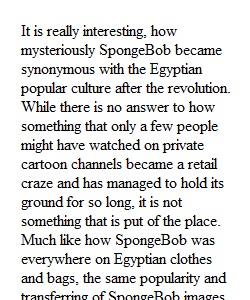


Q B) SpongeBob on the Nile This week you learned that while aspects of one culture may be adopted by another, they are often adapted to local meanings, needs, and purposes. You also read two articles and observed a Tumblr page dedicated to the recently observed phenomena of the proliferation of SpongeBob SquarePants, an American cartoon character, in many aspects of material culture in Egypt. In this discussion board, complete all of the following: • Consider one way in which the adoption of SpongeBob SquarePants into Egyptian culture appears to be similar to its original role in American culture. • Also consider one way in which Egyptian culture appears to use this icon differently. • Provide a specific example and explanation of each and where you found this example – such as a link and, if you are referring to a photo, a description of the photo. You may also re-post the photo here as part of your discussion board post. Be sure to credit the source. You may also, in a separate paragraph, describe your personal response to this article. What sorts of questions might an anthropologist ask and want to answer about this phenomenon? What does this make you curious about? Have you ever observed the globalization of a cultural icon/product firsthand? How was the item incorporated similarly or differently in the culture it was adopted into? How does this relate to your lecture and readings from this week?
View Related Questions